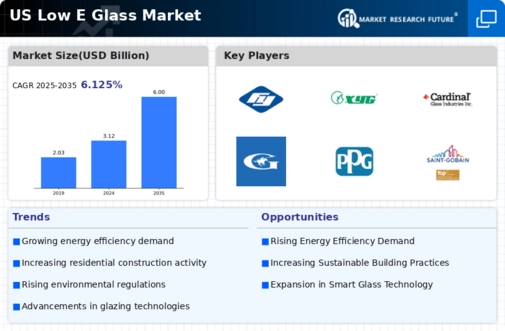The US Low E Glass Market has been experiencing robust growth driven by increasing awareness of energy efficiency and sustainable building practices. Low emissivity (Low E) glass, known for its ability to reduce heating and cooling costs by minimizing thermal transfer, is becoming a standard in residential and commercial construction. As the demand for high-performance building materials escalates, various players in the market are intensifying their competitive strategies to capture a larger share.
Companies are focusing on technological advancements, product innovation, and strategic partnerships to meet the evolving needs of customers while adhering to regulatory standards aimed at reducing energy consumption and greenhouse gas emissions. Competitive dynamics also include factors such as pricing strategies, distribution networks, and customer service excellence that influence market positioning.Fuyao Glass America stands out in the US Low E Glass Market due to its strong commitment to innovation and quality.
As a prominent player in the glass manufacturing sector, Fuyao Glass America leverages advanced technology and production techniques to provide high-performance Low E glass solutions that meet stringent industry standards. The company has established a solid presence across various regions in the US, catering to both residential and commercial clients. Its strengths lie in its robust supply chain, extensive distribution network, and the ability to produce customized and context-specific solutions that cater to unique client needs.
Additionally, Fuyao's focus on research and development enables it to introduce new, energy-efficient products that comply with evolving regulations, thus enhancing its competitive advantage in this dynamic market.Xinyi Glass holds a significant position in the US Low E Glass Market, known for its diverse product range that includes high-quality Low E glass used in a variety of applications, from architectural to automotive. The company has made substantial investments in state-of-the-art manufacturing facilities in the US, allowing it to efficiently meet local demand while maintaining high standards of quality and environmental compliance.
Xinyi Glass's key strengths include its strong brand reputation, innovative production techniques, and a commitment to sustainability, which resonates well with the growing emphasis on eco-friendly building materials. The company is also active in mergers and acquisitions, which further strengthens its market presence and expands its product offerings. By continuously enhancing its technological capabilities and optimizing its operational efficiencies, Xinyi Glass remains a competitive force in the US market, adeptly responding to shifting consumer preferences and regulatory landscapes.


















